
Its History, Legends and Lore / by Dorothy V. Corson

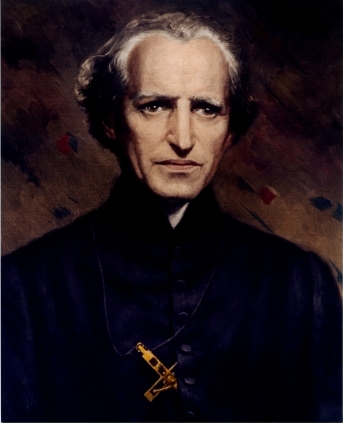
On March 21, 2007 the News and Information Department of the University of Notre Dame released this information about Father Moreau who will be beatified September 15, 2007 in France. The following excerpts about Father Moreau’s background are from their release:
Father Moreau was born February 11, 1799, in the French village of Laige-en-Belin to a poor family of wine peddlers, the ninth of 14 children. He attended a parish school where his prayerfulness and intellectual acumen were soon noticed by the pastor. Persuaded that he was called to the priesthood, his parents sent him to a preparatory seminary, and he was ordained by the time he had reached the age of 22.
Father Moreau quickly earned a reputation as an absorbing and inspiring preacher. He became a popular seminary teacher and administrator, as remarkable for his strong character and iron will as for his personal piety and care for the outcast.
“If you have a marked preference for certain people,” he instructed his students, “It should be for the poorest, the most abandoned … the least gifted by nature … If you surround them with the assiduous attention, it is because their needs are greater, and it is only justice to give more to those who have received less.”
As a priest of the diocese of Le Mans, Father Moreau established in 1837 the Association of Holy Cross, consisting of two societies, one of men (brothers and priests) and one of women, for the principal purpose of the education of young people and evangelization. His best known follower was Rev. Edward F. Sorin, C.S.C., Notre Dame’s founder. Moreau died in 1873.
In the South Bend area, the priests are known for founding Notre Dame; the brothers, for Holy Cross College and Holy Cross Village at Notre Dame; and the Sisters of the Holy Cross, for Saint Mary’s College and Saint Joseph Medical Center.
The above descriptions of Fr. Moreau’s personality are especially interesting and will set the stage for descriptions of the events that will follow which occurred during his only visit to America. It is interesting to note that the anniversary of Father Basil Anthony Mary Moreau’s birthday is February 11, which is the date Bernadette first saw her vision of Mary at the Lourdes Grotto in France. It is also a date now celebrated as Lourdes Day at the Grotto of Lourdes on the campus of the University of Notre Dame.
For more information about Moreau’s Beatification go to the Notre Dame News and Information Website
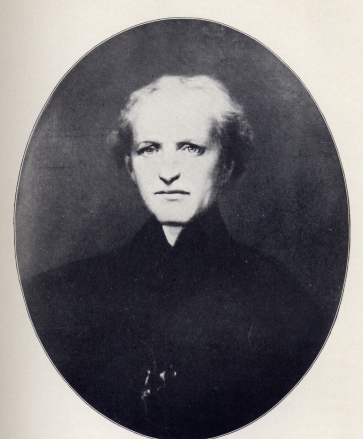
An early St. Mary's history book, On The King’s Highway, by Sr. M Eleanore (C.S.C., ) published in 1931, describes Fr. Moreau’s arrival at Notre Dame and the interesting events that occurred during his stay. One firsthand description, centered on the island at Saint Mary’s, has also been lost in time and mostly forgotten. It seems only fitting to share it again in memory of Father Moreau upon the occasion of the year of his beatification which is also the sesquicentennial of his first visit to America 150 years ago.
Father Moreau was profoundly attached to his homeland. The church and the religious were his intimate family circle yet at the same time he expressed in his Circular Letters that he felt his visit to America, was “a grave duty. . . toward those generous souls who have made the sacrifice of their homeland, and whom I have exposed to so many dangers by sending them beyond the seas.”
Sixteen years had past since Rev. Edward Sorin and a little band of six French Missionaries started from the mother house of the Holy Cross Order at the City of Mans, France, on a journey to the mission fields of distant Indiana. Three months after their departure they stood together on the frozen shore of St. Mary’s Lake at Notre Dame, and from that day began the history of the university which bears that name.
Now it was 1857, and Father Moreau was crossing the ocean to see his children in their new homeland. It was his first journey to America. He was accompanied by a newly ordained Father Louis L'Etourneau. A young American religious who had just completed his theological studies at St. Bridget's in Rome and was destined to be Prefect of Discipline and Master of Novices for the Brothers at Notre Dame du Lac. This was same Father L'Etourneau who would be present 50 years later at the celebration of the centenary of the Sorin's Monument and the Log Chapel in 1906.
Father Moreau and Father L'Etourneau embarked at Le Havre, France on July 28, 1857 on the steamer, the SS. Fulton. The ocean crossing was very difficult. Fr. Moreau wrote that "the boat was pitching almost continually, while the temperature remained quite cold and the winds were against them. This, however, struck him as being almost nothing in comparison with the sufferings endured by other Holy Cross missionaries in some of their crossings."
Young Father L'Etourneau ... provided further details. "There were fourteen religious, from different congregations, on board the Fulton ... all of them were charmed by the 'marvelous gaiety' of the Superior of Holy Cross. It is rare that we find such a tribute paid to Father Moreau, whose facial expression and everything we know of his interior life has an air of undeniable austerity. But in souls united with God, joy is a light which comes from within. During some stormy nights, a feeling of dread took hold of the ship, but Father Moreau kept 'his calm and his smile.'" -- Basil Anthony Mary Moreau by Catta & Heston. p. 306.
They reached New York on August 11 but did not stay there long. They took the train that same evening for Montreal arriving there the next day. After a visit with his "beloved Canadians" of the Holy Cross was carried out, on the 23rd of August, Father Moreau, together with his young companion, Father L'Etourneau, boarded a train for Indiana.... On August 26, in the morning, the two travelers reached South Bend. Here again, at least relatively speaking, the arrival of the Superior General was a surprise. Father Granger, who had gone to meet Father Moreau, expecting to find him in Detroit, missed him and came in the day after.
Father Moreau left his own description of his arrival at Notre Dame: "I got out of the carriage at the post office, and my presence astonished the Irish Brother who was busy sorting mail. The news of my arrival soon spread. The large church bell and the twenty-two others that make up the magnificent Bollee chime began to ring out. Just as at Saint-Laurent, there was much running about and everyone was asking: 'Why are they ringing the bells? Why all the excitement?'"
"There was surprise on every face, and all the excitement ended in the church at Notre Dame, where Father Moreau intoned the Te Deum and then celebrated Holy Mass in thanksgiving. Father Sorin who was absent at the moment, arrived later that day. He had been preaching a retreat for the Marianites in Chicago, and sickness had obliged him to delay his return to Notre Dame. Father Moreau awaited his arrival before going in the afternoon to visit the Sisters. Ibid. ps. 307-309.
The past history of Notre Dame was still linked to the present in 1906, by the presence of Father L'Etourneau. And 100 years later in the 21st Century his presence is felt once again, in remembrance, during the 21st Century centennials of the Sorin’s Monument and the replica of the original Log Chapel which both occurred on May 3, 1906.
Thus it was that the young Father L'Etourneau was also in the picture when Father Moreau, the founder of the Holy Cross Order, arrived at Notre Dame from Europe on his first visit to his children in the New World.
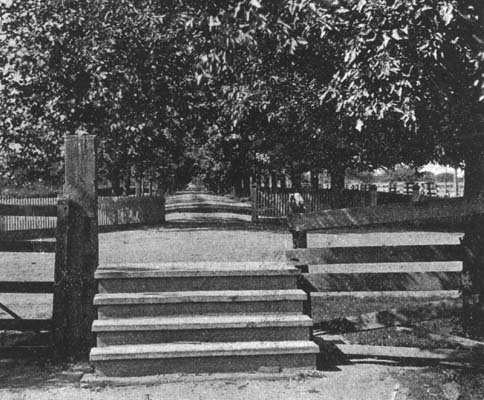
In her book, On the King’s Highway Sr. M Eleanore shares Sr. M. Elizabeth’s description of the events that occurred during Father Moreau’s visit to St. Mary’s:
In the summer of 1857 Father Sorin told the Sisters that Father Moreau soon would visit his children in Canada and the United States. This was a joyful surprise to all, especially to the French Sisters to whom he would come, not as an unknown Founder, but as a Father and representative of home; and for weeks they could talk of nothing else but the Mother House and Father Rector. Mother M. Angela was besieged with questions by the Sisters of other nationalities, and for their benefit she related again and again what she had seen and whom she had met in France until Fathers Moreau, Chappe, Champeau, Drouelle, and others became real persons to the Sisters. Because the Father Founder would visit every place, there must be initiated a grand housecleaning from garret to cellar--one of those supererogatory acts of devotion that no one outside a convent ever sees to be necessary. If one dare to draw so frivolous a simile one may say that this preparation ran true to the order of the exercises of St. Ignatius; the housecleaning being the purgative way and the aftermath of the Visit the illuminative way, for, according to Mother M. Elizabeth’s account, "this great event was the beginning of a new life and was the cause of our future growth as an active teaching order.”
On the evening of Father Moreau’s arrival Father Sorin sent a messenger to say that the Father Founder would come to St. Mary’s the next morning. Father Granger and Father Sorin would bring Father Moreau in the carriage and the other priests from Notre Dame would follow in the omnibus. Because we cannot possibly improve on the account of an eyewitness, we shall let Mother M. Elizabeth tell of the preparations for this happy and momentous Visit that was to bring a blessing upon St. Mary’s future:
Mother M. Angela sent for the cook and ordered her to prepare a grand dinner, being sure to have a ragout and wines. When Sister M. Emily heard the news, her facial surprise, her gestures, and her movements, so malapropos and yet so naïve, convulsed Mother M. Angela, who finally recovering, said: “Sister, you must have the Sisters and pupils form a procession, have the Children of Mary dressed in white, carrying banners, walk in procession to the gate, and when Father enters have them kneel for his blessing and then sign the Magnificat.”
Accordingly, after breakfast, everything about the house was put in final order—not much of a task because there was very little furniture—and all assembled in front of the building. Before they started Mother said that the youngest children should be nearest the gate and should scatter flowers on the path on which Father Moreau, after alighting from the carriage would walk toward the house. After that Magnificat they were to sing the Ave Maris Stella and the O Sanctissima until they arrived in front of the Academy, where chairs would be placed for the guests and the procession would form in circles. Then Miss Sweeney would read an address of welcome in French. At this moment the Brothers, most of then being of the earliest bands who had come from France, asked where they should take their position. “Oh,” said Mother M. Angela, “you must be the very first to greet him while he is still outside the gate, and then I with the oldest Sisters will welcome him next.”
So everybody passed joyfully down the gravel path to the gate. After waiting for an hour, Mother M. Angela began to get uneasy. Once the appearance of the bread wagon caused considerable agitation. As everyone was tired of standing in line, all were told to sit down in the fence corners, holding themselves ready to get immediately into position. Then a Sister who was watching whispered to Mother: “I see someone coming through the trees by Father Granger’s place. Perhaps it is a seminarian coming to tell us what has detained Father. It doesn’t look like a Brother, and yet he has no cape. He has a hat under his arm and is reading a book.”
When the man came nearer and reached the stile, [an arrangement of steps for getting over a fence or wall, while forming a barrier to the passage of sheep or cattle which led to St. Mary's Academy] he stopped and looked up and down the road, uncertain which way to take, for our buildings were not high enough to be seen at that distance when the trees were in full leaf. Then Sister M. Emily cried out, “Father Rector,” and, followed pell-mell by Mother M. Angela and all the French Sisters and Brothers, ran to him and knelt at his feet. Mother M. Angela then whispered to Sister M. Emily to return and get the procession in order. As Father Moreau walked along with everybody talking to him at once he did not notice the procession inside the gate until the choir began the Magnificat. When the children began to strew flowers before him he turned to Mother M. Angela and shaking his head cried out: “No, no! I am but a poor pilgrim. Flowers only before the Blessed Sacrament.”
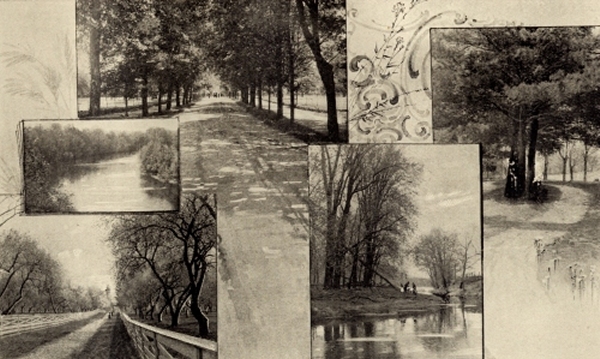
Mother immediately translated what he had said and told the children they might give Father their bouquets after they had reached the Academy and Miss Sweeney had given her address. All went smoothly. Then Father Rector rose from his chair and thanked everybody, making his French phrases plain by his gestures. It was apparent that he was charmed by his reception, the beautiful scenery, and the many birds that flew around about him, seemingly not afraid. He said that he knew how pleased the priests and the Sisters in France would be when he would write to them of beautiful America. Here he was interrupted by the sound of carriage wheels stopping near the river bank. Then Father Sorin and all the clergy from Notre Dame came forward and knelt for Father Rector’s blessing, to the astonishment of the pupils, who had not dreamed that anyone less than the Pope could possibly be above their Father Superior.
Soon all were seated and then Father Sorin rose and said: “I am going to tell you what a trick Father Rector played on us this morning. The Fathers and I would like to explain our absence and why we were deprived of the pleasure of introducing our distinguished Founder and guest to you in a more fitting manner, although you seem already to have taken him captive. We never thought that after the fatigue of his journey he would rise at his usual hour, and we expected his Mass to be after the others. When the breakfast bell rang we went to the refectory and knowing his punctuality were surprised at his absence. We sent to his room, found the bed made and his trunk unopened. Imagine our alarm. No one had seen him, for the Brother who served his Mass was at work in the field on the road to South Bend. When questioned he, of course, knew nothing except that he had left Father in the church to make his thanksgiving. Some hurried to the Sisters’ house, some to Father Granger’s novitiate, some to the apprentices’ house. One of the priests saw a little boy fishing and rushed to ask him whether he had seen a strange priest near either of the lakes. The boy said that he had seen one about an hour ago. Then we decided to drive over here to St. Mary’s and, if Father were not here, to drag the lakes, for we feared he might have risen early to take a bath.”
Father Rector sat there wondering what sort of speech was being made. When it was translated to him, he laughed heartily, and said: “I walked on saying my Office till I came to a road. I was wondering where it led, when I was suddenly surrounded by these good Sisters and dear children. I was so glad to be at St. Mary’s that I never thought of being a source of uneasiness, for which I beg your pardon."
... The next morning after High Mass, Father Moreau began his Visitation. He went everywhere on the premises with his staff officers. His quick eye took in at once the extreme poverty and he understood the few discontented letters he had received. His words showed that he was highly edified by the cheerfulness with which most of the Sisters had endured the hardships. He then saw each member in private, giving those who could not speak French, permission to select their own interpreter. -- On The King's Highway pp. 206-210
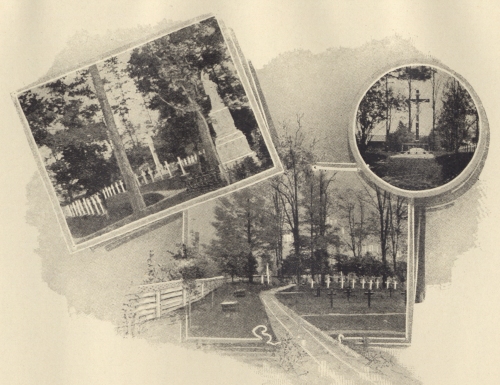
One of the dearest places at St. Mary’s is the dormitory which summer carpets with green and winter blankets with white, the dormitory over which the tall Crucifix keeps guard and the trees sing lullabies to those who are themselves singing Hosannas; and to us all it is doubly dear because it was hallowed by the footsteps of our beloved Father Founder. -- On the King's Highway, p.213.
It was Father Moreau himself who chose and blessed the site of the convent cemetery on his visit to America in 1857. “Here shall our dear dead lie,” he said, pointing to the peaceful spot that lay with the shadow of great cedars that reached out kind, protecting arms. Today our arms stretch out lovingly across this little city of the dead, the arms of Christ on the Tree of the Cross.
The small plot under the shade has lengthened and widened with the years into more open spaces of the sun. The honor roll of the dead now numbers more than 1,000. Each grave is marked by a simple white cross, bearing the Sister's name in religion, her family name, the dates of her birth, profession, and death. Even a Sister who dies on some distant mission and is buried there has this small white cross at the mother house for remembrance's sake. Holy Cross never forgets its dead. The very first rule written by Father Moreau shows thought of them. In this he prescribes that on the day before the anniversary of a Sister's death her name be read in the refectory to call her soul to mind. Upon the death of a religious, Masses are at once offered in each house and special prayers are said by each member for the dear departed. These suffrages are, in the words of Father Moreau, "among the most precious consolations offered by the communiity to a religious soul." Another constant reminder of the dead is the obituary list placed in each house at the entrance to the chapel or community room. Many an aspiration is breathed to and for them as the Sisters hurry by on their daily duties....
There are Sister yet living who cherish recollections of God's Acre in olden days when wild flowers of every sort spilled their fragance there, and a little white fence led down to the shrine of Our Lady of Peace. Many a basket of rich earth we carried there from the ravine. On each little mound we planted moss in the shape of a cross...."
Our Lady of Peace Cemetery, whether in the green of summer, or the whiteness of winter, is a beloved and frequented spot. Many a hidden saint is enfolded in its bosom. Here the Sisters keep sweet communion with their dead, and always the wind and grasses echo the blessing of their founder, "Rest, rest in peace children of Holy Cross."-- Our Mother House pp. 89, 90, 91.
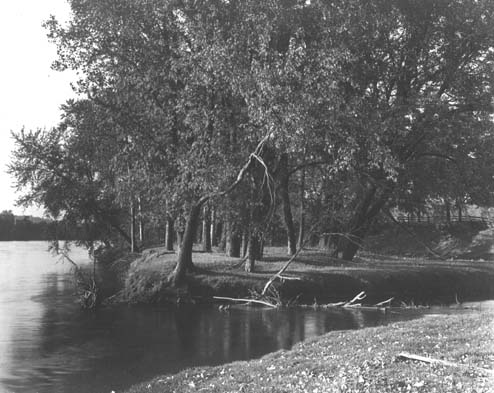
Another interesting event centered on the island at Saint Mary’s, now mostly forgotten 150 years later, occurred when Father Moreau, the founder of the Holy Cross Order, arrived at Notre Dame from Europe on his first visit to the New World. While visiting the newly established St. Mary's Academy, he blessed little St. Angela's Island and gave it its name. He also blessed its altar and statue of Mary. It was later referred to as the shrine of Our Lady of Lourdes. A special welcome was planned for him by Mother Angela. In Sr. M. Eleanore’s book, On the King's Highway Mother M. Elizabeth describes the ceremony:
The summer of 1857 filled the community's cup of joy to the brim. It brought a visit from Father Moreau. Long had the father founder desired to see the fruit of his children's labors in foreign lands. It was twenty years since he had founded his congregation. Business did not exclude pleasure, however, as an account of the blessing of Saint Angela's Island clearly shows. It was the feast of Our Lady's Nativity.... -- On the King's Highway, ps 214, 215 From Life of Mother M. Angela (MS)
Sr. M. Eleanore, C.S.C. records Mother M. Elizabeth's detailed description of the elaborate ceremony she witnessed: By way of preparation Mother M. Angela borrowed from town several bolts of muslin for decorative purposes. Joseph and a few other men hired for the day hauled brushwood to make bonfires at short distances apart on the way to the island. Under a large tree on the island they erected an altar, which the Sisters decorated with candles and wildflowers. On a wire between the trees in front of the altar they hung a large lamp frame made of white down and feathers. On the trees along the path leading to the altar they put small tin holders for candles and nailed pictures under them. The bridge was draped in muslin and was lit by colored lamps.
In the afternoon the Sister sacristan at Notre Dame sent over to the Academy parlor the surplices of the priests. There was an early supper, after which all the Sisters from St. Mary's and from Notre Dame formed in procession with lighted candles. At seven o'clock Father Rector and the clergy having been invited to what they supposed was a little entertainment, came from Notre Dame, took chairs, placed them in front of the Academy, and began to smoke and enjoy themselves in the company of Mother M. Angela and her Council. When the bell rang, Mother invited the clergy into the parlor and asked them to put on their surplices. They were somewhat surprised until Mother told them that the Sisters wished to have Father Rector bless the island. At her request the clergy took ranks. She then opened the back door of the Academy to disclose to their astonished gaze the illuminated path which seemed a fairyland of light. Father Moreau stood as if entranced.
The long procession filed through the woods, singing as they went. In half an hour they reached the rustic bridge, where the Sisters halted in ranks through which the clergy passed. Father Moreau blessed the island, giving it the name of St. Angela. Father Sorin and Father Sheil, Provincial of New Orleans, were his assistants. After the blessing Father Rector spoke to us in French, which Father Sheil translated for us. Father Moreau expressed his extreme pleasure over finding in the woods of far-off Indiana such great love for the Mother of God and promised that he would never forget the heavenly scene he witnessed that evening on ground consecrated to Mary Immaculate. He said he had much to say, but the American night birds sang so loud he could not make himself heard. These night birds were the katy-dids and the tree frogs who were shouting their protest against this invasion of light and human sound into their own domain. No matter what katy did or didn't do on other occasions, on that night, at least, she out-talked a whole religious community. Some few persons complained to Father Moreau because Mother M. Angela had burned so many candles; but he reminded them of a certain box of ointment once poured on the Master's feet....
The farewell ceremony took place on September 15, the following morning, at an early hour. "Tears were shed," wrote Father Moreau, "as the religious knelt to receive my last blessing; they clung to my neck and showered upon me countless expressions of tenderness." He then added that, "after having done his best, he was going home happy."
It was one o'clock in the morning of September 19 when Father Moreau and Father Sorin bade each other farewell at the station in Philadelphia.... At five o'clock Father Moreau arrived in New York, and at eleven boarded the steamer Arago, which weighed anchor for France that same evening. Ibid. pages 314, 315.
This time Father Moreau had as his traveling companion Brother Vincent, who had been elected one of the general assistants. Off the coast of Newfoundland, between September 22 and 23, the ship encountered a violent storm in the midst of a heavy fog. Father Moreau described the storm in the Circular which acquainted his sons and daughters with all the details of his trip, and which he began to write as soon as the storm had begun to abate. He was anxious to finish this letter, knowing that as soon as he returned to Le Mans he would be completely taken up with the business which had accumulated in his absence. The sea was so violent that at times Brother Vincent had to hold down the inkwell and the paper. The storm made a lasting impression on the two travelers, as can be gathered from an account contained in Father Moreau's Circular: Ibid., p. 315.
From the depths of the sea there arose mountains of water which at times broke against our vessel with a noise like a cannon shot, and then at others rose high above the bridge and fell in torrents on our poor sailors who were busy with the steering. To the rush and roar of the foaming waves, add the irregular rocking of our ship in the throes of violent pitching, the clanging of the bell, and the screeching of the whistle through the darkness to warn other vessels of our approach. Then picture the rolling and pell-mell confusion of trunks, kitchenware, and chairs; the rhythmic shouts of the sailors as they hauled in their sails and coiled their ropes; the creaking of our cabin walls, which seemed on the point of splitting, and the noisy slamming of doors. Picture all this, and you will have some idea of the terrifying scene we have just been through. Circular of September 25; Circular Letters, Vol. 2, p. 28.
This experience must have been all the more impressive because, just before leaving New York, the travelers had received news that a steamer call The Central American had been wrecked in that vicinity, and had gone down with more than four hundred persons on board. It was the dangerous season of the equinox. Brother Vincent remarked to Father Moreau: "How they would tremble for us at Sainte-Croix, if they knew you were exposed to such dangers!" But in the midst of the storm, Father Moreau was calm. "God," he wrote, "gave me grace to fear nothing." Ibid p. 316.
This time also he composed a few verses of a hymn, which he sang with Brother Vincent. It was a hymn to the Blessed Virgin, in which he sang of his confidence in Mary, Star of the Sea, even in the midst of roaring waves.... Ibid p. 317.
Fr. Moreau and Brother Vincent left Notre Dame and journeyed to New York where they boarded the steamer, Arago. Though their passage was difficult and dangerous they arrived in their homeland safely and were welcomed back into the loving arms and grateful hearts of the Holy Cross Congregation Community in France.
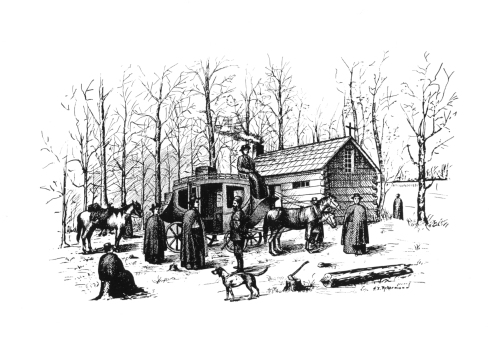
It is my belief that history becomes more alive when the actual words and deeds of those who came before us are compiled and passed on. So that 100 years later, they may be brought to life again in remembrance of them. Therefore, I have let them tell their stories in their own warmly personal way, as they were happening, so that their impressive first-hand experiences might be shared as closely as possible to the way they lived them more than 100 years ago.
More photographs and a German Missionary's description of the Log Chapel and its surroundings are recorded in the published book, A Cave of Candles: The Story Behind the Notre Dame Grotto -- The Spirit, History, Legends and Lore of Notre Dame and Saint Mary's, by Dorothy V. Corson. It is now available at the Notre Dame Bookstore; from Evangel Press at this Toll Free Number 1-8oo-253-9315 Ext. 239; at Amazon.com; and at other local and national bookstores.
Additional historical information is also on her The Spirit of Notre Dame Internet Website. For more photographs and detailed online information about the Log Chapel try A Sacred Place, German Missionary's Diary, and Notre Dame's Photo Gallery
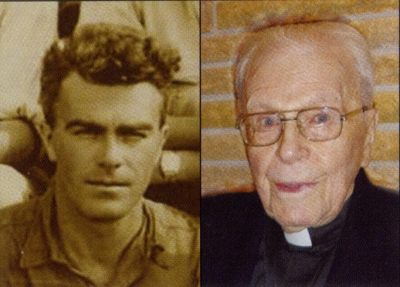
|
| Fr. Walter L. McInerney, C.S.C. |
Before my work on this latest website addition was completed, yet another chance happening occurred. When I was going over Father Mooney's archival file the thought came to my mind that perhaps someone might still be living who knew him and the story he told about Rockne.
Father Mooney was born in 1892 and died in 1963, it was very unlikely that any Holy Cross Priest would be living who knew him. However, by coincidence or providence, a Brother friend suggested Father Walter McInerney: "If anyone would have known him, he would," he said. "He turned 101 in February and is as sharp as ever."
In celebration of his 100th birthday, the May 2006 issue of the Province Review had this to say about Father Walt:
"A gifted singer he was a member of the Moreau choir that sang at Knute Rockne's funeral. In his day, Father Walt was often called the best retreat master in America. He had a booming voice that would fill a cathedral without yelling. He delivered all his conferences without notes claiming the Holy Spirit was his inspiration and guide."
Father Walter McInerney, C.S.C. was a delight to visit. Alert, charming, and witty, doesn't begin to describe his engaging personality. To reach 101 in good health and fine spirit is a glorious accomplishment. It was also perfectly timed. He came into this world in 1906 the same year the Sorin Monument was created and the Log Chapel rebuilt. I now had another centenary to add to my list of special events for Notre Dame and Saint Mary's to commemorate in the 21st Century.
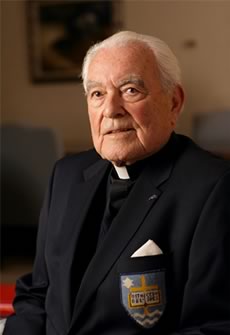
|
|
Rev. Theodore M. Hesburgh, C.S.C. President Emeritus |
The first item in Father McInerney's Indiana Province Archives Center file made an immediate connection: "His baritone rang out with the choir at Knute Rockne's funeral." He was 25 years old. The Very Rev. Charles L. O'Donnell, C.S.C. delivered the eulogy in Sacred Heart Church and conducted the rites at the grave in Highland cemetery.
Father McInerney celebrated his 100th birthday on February 23, 2006 which is also a significant date in the history of the Lourdes Grotto in France. On that day in February, Bernadette was ordered not to return to the Grotto. Although forbidden to go there, on February 23rd she returned to the Grotto and the vision appeared again.
In 2007, Father McInerney, who is now 101 years old continues to hold the record as the oldest surviving priest in the Holy Cross Order. Thus my three centennials associated with 1906-1907 had now become four to celebrate.
Three centennials, the Grotto's 110th Anniversary, the sesquicentennial of Moreau's only visit to America, his beatification on September 15, 2007, and Fr. McInerney's 101st birthday, make an impressive list of special events for Notre Dame and Saint Mary's to commemorate.
Adding the 90th Birthday of Rev. Theodore M. Hesburgh, C.S.C., President Emeritus, on May 25, 2007 makes 2006 and 2007 banner years for celebration in the 21st Century.
The double centennial celebration of Sorin's Monument and the Log Chapel replica must have been an impressive event in May 100 years ago:
"After a Solemn Pontifical Mass in the sanctuary a procession of three thousand or more was formed from the church to the entrance of the grounds where the statue of Father Sorin was unveiled while the University Band played music appropriate to the occasion."
I would like to dedicate these “Afterthoughts” to the memory of Rev. Sigmund Jankowski, C.S.C. and my father, Wm. Buckles. It was the inspiration of their creation, the St. Stanislaus Grotto, and my knowing the story behind it, that planted a wish in my heart to know more about the Grotto of Lourdes at the University of Notre Dame.
If they had not followed their inspirations, I would not be following mine today in sharing my adventures on that "Trail of Memories" on my The Spirit of Notre Dame website and in my newly published A Cave of Candles book. The many strangers I have met along the way, who have become friends, have enriched my life in more ways than I can count.
And it all began with the warmth and welcome that was first extended to me at the Fatima Mission House, by Father Jankowski who resided there when I met him seven years after my first glimpse of the St. Stanislaus Grotto. See The Keystone for more details. Two years later, Fr. “Jan” suffered a stroke and was transferred to Holy Cross House, the Retirement Home for priests, on the banks of St. Joseph Lake.
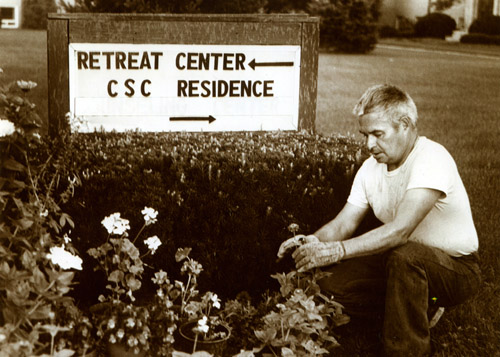
When Fr. “Jan” passed away at Holy Cross House, in 1975, I was adopted in friendship by Brother Edward and Brother Cosmos. They urged me to continue my visits with the other priests I had met since Fr. Jan’s arrival there and I gave them my promise: “As long as one person wants me there I'll be there.” I never dreamed I would still be visiting that “Vestibule of Heaven” on campus thirty-five year later in the 21st century.
When Fr. Jan was transferred to Holy Cross House, I also stopped, now and then, at the Fatima Retreat Center on St. Mary's Lake to visit his friend, Brother Chet. He was the groundskeeper at the Mission House when Father Jan lived there.
We would sip hot chocolate in their lunch room in the wintertime and feed the geese and ducks in the summertime. It was Brother Chet who encouraged my passion to know more about the Grotto. He was very fond of St. Therese, “The Little Flower.” These thoughts of hers which he shared with me one day made an indelible impression upon me: “Be like a leaf in the wind and let it blow you wherever it will.” It has motivated my historical research on campus ever since.
Brother Chet's quiet ways enriched many a visit to Fatima on my way home from errands in town. One day he showed me a flower in the gardens he tended at Fatima. “It’s called Queen Anne’s Lace,” he said, and then he added, “Nature and people are a lot like Queen Anne’s Lace. You have to get close to them to truly appreciate them."
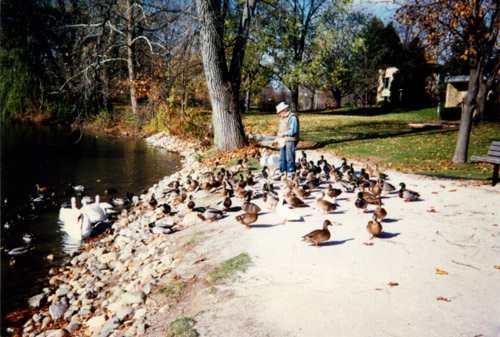
Brother Chet was St. Francis to the wildlife all over the campus in all kinds of weather. He could even get a bright red cardinal to eat out of his hand. Looking back on those 35 years of shared friendships, I feel truly blessed by the lessons life has taught me in following my own inspirations in researching the history of Our Lady’s University and her Lourdes Grotto. It has been an adventure following those intuitive impulses.
For instance, in the midst of following my inspiration to write these “Afterthoughts,” I found among my papers, a 2” x 4” scrap of paper upon which I had apparently scribbled down an excerpt from my reading that impressed me in the past. It was my handwriting, but I did not recall ever seeing it before. Rereading it was a pleasant surprise. On that little scrap of paper, the unknown author who wrote it, had captured the essence of the meaning of the word, "inspiration," in a way I had never seen done before:
Inspiration is a calling to proceed even though we’re unsure of goals and achievements. It may even insist that we go in the direction of unchartered territory. Inspiration is surrendering to our destiny and allowing ourselves to hear the call. To try things and see what happens. And if you fail that’s okay, too. It’s trying that’s important.
It reaffirmed my own experiences throughout my sixteen years of research on campus: When you open your heart and your mind to that Guiding Spirit within, it will take you places you never dreamed were possible.
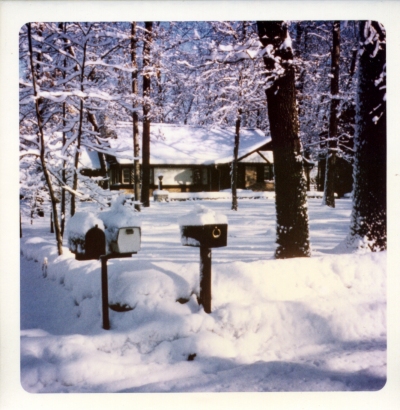
My heartfelt appreciation goes out, once again, to all those ANGELS UNAWARE, whose Heaven-sent help and encouragement throughout my odyssey of discovery, have made The Spirit of Notre Dame: Its History, Legends and Lore website, and my new book, A Cave of Candles: The Story Behind Notre Dame's Grotto, a reality.
Dorothy V. Corson<< back | The Spirit of Notre Dame | next >>